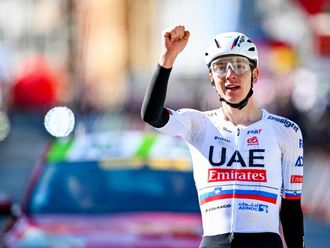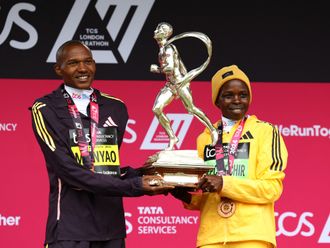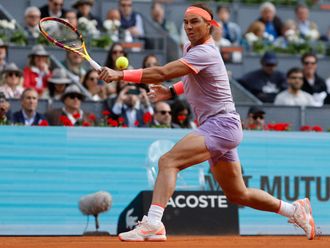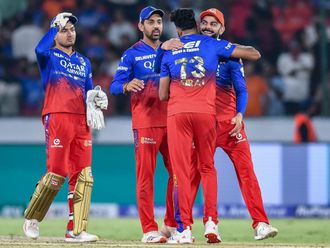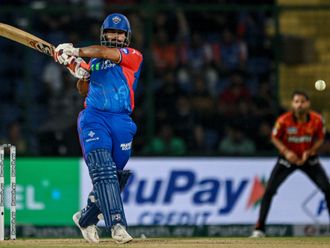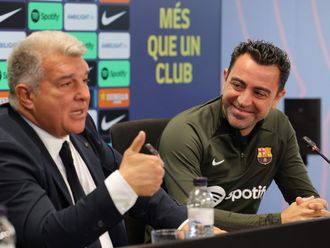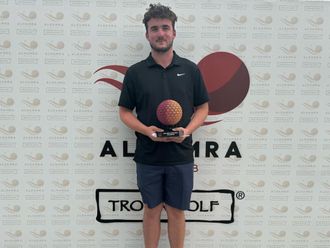The man sitting next to me on a luxurious, L-shaped cream sofa at his open-plan home in Pretoria, South Africa, is a sprinter. He is a man who has now met the qualifying ‘A' standard to run in the 400 metres at the Olympic Games in London and will also go for four gold medals at the Paralympic Games.
But, Oscar Pistorius is also a double amputee. He was born without a fibula, the bone that connects the knee to the ankle. This sprinter's legs end just below his knees.
In the day-and-a-half photographer Andy Hooper and I spent with Pistorius in and around Pretoria, we tried to find out what makes this sprinter tick. What is the Blade Runner like away from the track?
Pistorius drives his big black BMW through Pretoria's leafy, well-heeled suburbs like a racing car driver.
The good-looking, 25-year-old driver — a man recently voted South Africa's best-dressed by GQ magazine — attracts admiring glances when we pause in the heavy traffic.
This car is still quick and impressive, but it is the safe option for Pistorius, designed to protect him in the event of a crash. An adrenaline junkie by nature, he insists he has given up all that stuff to pursue his dream of competing at the Olympics.
The walls of his home are adorned with signed boxing memorabilia. Pistorius' double garage is littered with kit — skis, snowboards, boxing gloves and bicycles — but they remain unused, for now at least.
Rugby injury
He has sold 11 motorcycles over the past two years to focus on this sport he fell into almost by accident, when a knee injury stopped him playing rugby at boarding school and he began athletics as a form of rehabilitation.
"We grew up on bikes," he says. "There's a picture of me wheeling a motorbike when I was about six years old. But sometimes you just have to realise that, although you don't want to stop the things you enjoy for anything, you have to realise that there are priorities sometimes. There's no point, when you're working so hard for something, in inviting the possibility you could mess it up. Things could go wrong on a bike very quickly.
"I used to race every second or third weekend. You crash pretty often. Even if you just twist a wrist or something, it can affect your start, or your technique. It's just not worth it."
Pistorius also crashed his powerboat into a submerged pier in 2008, breaking two ribs, his jaw and an eye socket, and had to have 172 stitches. "The boat's gone, too," he adds. "We don't do that stuff anymore. It was quite difficult to get that out of my system. I miss that quite a bit.
"There will be a time for that in the future but, right now, I would be quite upset if I got injured. There must be other ways I can unwind. It's a small sacrifice."
He reads, paints, and plays the odd nine holes of golf instead, but you feel it has been very difficult, letting go of the pursuit of going dizzyingly, dangerously fast.
Pistorius is still chasing that buzz in a purer way, of course, just him, the track and the clock, but it is as if he has had to learn to respect his body, realising that it might just not be unbreakable after all.
Chasing the impossible
There is something of an irony in this, but Pistorius is a man who does not comprehend the concept of ‘cannot'.
The book Pistorius is reading is called The Just Defiance by Peter Harris, about the African National Congress' campaign of violence during apartheid.
Pistorius grew up in a comfortable white family. He has a black live-in caretaker, Frankie, and trains with a Zimbabwe 400m runner, Talkmore Nyongani. He says he finds it fascinating, looking back at his nation's history and politics.
"My generation weren't affected by apartheid, so it's very difficult for us to understand sometimes," he says. "We had dinner last night for my sister Aimee's birthday. We sat at a table with 20 people and, without even noticing, she's got a third black friends, a third Indian and a third white.
"We see things as black and white, but there's often a lot of grey in between. Whether it be right or wrong is a different story, but it's good to appreciate other people's views. Sometimes, people feel they have to make a stand, but it becomes more about egos than anything else. They try to prove a point and end up doing even more damage."
Argument of prosthetics
He could be talking about his own fight here, the successful battle for the Court of Arbitration for Sport to conclude his carbon-fibre blades do not give him an advantage on the athletics track. But, in this case, it is his view that is very black and white.
"There are tens of thousands of people using the same prosthetics I use and there's no-one running the same times," he says. "You're always going to get people who have their opinions and offer their opinions but they can't explain things like that."
Childhood memories
One of Pistorius' first memories is hurtling down a hill on a go-kart with his brother, Carl, who then decided to use one of Oscar's prostheses as an impromptu brake to stop them crashing.
"My brother was like my hero when I was growing up," Pistorius said.
"Carl's not very good with normal sports. He's an adrenaline junkie. He does jet skis and white-river rafting and mountain-bike racing. He's like an action freak."
The boys' mother, Sheila, was the sort of woman who would tell Carl to put his shoes on and Oscar to put his legs on and ‘that's the last I want to hear of it'. She died on March 6, 2002 — a date Pistorius has tattooed on his arm after being wrongly diagnosed with hepatitis.
"She wrote us hundreds of letters and taught us hundreds of things and never made decisions for us. Those are the important lessons, when you try to do things sometimes and you don't succeed and you give up, and you never really know what the potential could have been if you had stayed dedicated to something."
The most dramatic difference between the Pistorius who just missed out on qualifying for the 2008 Olympics and the athlete who has already beaten the 45.30-second ‘A' standard for London 2012 is his weight.
He used to look like a rugby player; now, the Pistorius you will see at the BT Paralympic World Cup in Manchester on May 22, at the Paralympic Games in London and— if he can match the qualifying time at an international event — at the Olympic Games, looks more like a middle-distance runner.
Pistorius explains he has shed 17 kilograms over the past two-and-a-half years. His message is simple, brutal even. "If you've got extra weight, you've got to justify it," he says. "If it's not adding to the power-to-weight ratio, it has to go.
"You sometimes find sprinters fighting themselves when they're running. They're using a lot of aggression that's not getting transferred on to the track. It's a waste of energy, really."
Pistorius is not a big believer in wasting energy. He admits he didn't realise this when he was younger, but it's why the fast cars, motorbikes and powerboats have gone, allowing him to concentrate on Oscar the athlete.
As the tattoo on his left shoulder states: I do not run like a man running aimlessly.




